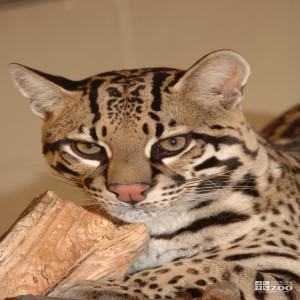Ocelot
[Leopardus pardalis mitis]

Ocelots have short, close fur marked with both solid and open dark spots that sometimes run in lines along the body. The tail is ringed with black or has black bars on the upper surface. The large ears are rounded with a prominent white spot on the back. These medium sized cats weigh 15.5 to 28.75 pounds, a head and body length of 26 to 39.25 inches and a tail length of 10.25 to 16.25 inches. Ocelots are strong swimmers and are able to cross rivers and move between patches of high ground in seasonally flooded habitats. The ocelots eyesight is six times better than a human's, so the animal has no trouble tracking down prey at night.
Location: The Upper RainForest
Share:
Range
The range of the ocelot is Southern Texas, Mexico, Central America and South America to Argentina.
Habitat
The ocelot inhabits tropical & subtropical evergreen forests, dry deciduous forests, dry scrub and seasonally flooded savannas
Conservation Status
Least ConcernPrimary Threats
Human-Wildlife CoexistenceGestation
Gestation lasts 78-82 days
Litter
1-3, usually 1
Behavior
Ocelots are solitary, with breeding females occupying non-overlapping territories of 0.3-5.8 square miles. Males have larger territories which overlap those of several breeding females. Ocelots are nocturnal. As they move about their territories they get to know their neighbors and they may stay together for several hours to as much as a couple of days. While some of these encounters are for mating, purposes of other associations are unknown.
Reproduction
Ocelot young begin to follow their mother at about 2 months but remain dependent on her for several more months. Young ocelots disperse from their natal range when they are about 2 years old. Females raise their young alone and may spend 17 hours a day hunting in order to find enough prey to support herself and her cub. The long gestation, small litter size and slow maturation of young may be adaptations for living under conditions where food is hard to find. In the northern part of their range births are normally in the fall and winter. In the tropics it is not likely there is seasonal breeding.
Wild Diet
Rodents, small mammals, occasional agouti, birds, fish, snakes, lizards and land crabs;
